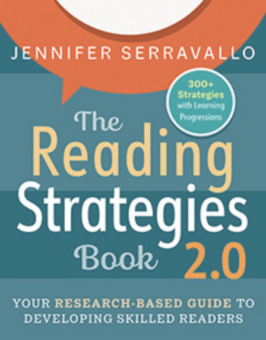The Reading Strategies Book Gets an Update
The Reading Strategies Book 2.0
By Jennifer Serravallo
(Heinemann, 2023 – Learn more)
Reviewed by Pam Hamilton

When I purchased The Reading Strategies Book by Jennifer Serravallo in 2015, I added that book to my cannot-be-improved list. I should have known better, having met her personally. ;)
The Reading Strategies Book 2.0 takes everything good about The Reading Strategies Book and makes it even better!

This book begins, as did the first, with “Getting Started.” In 2.0 this chapter explains strategies vs. skills, what the research says about strategy-based instruction, when to teach strategies, why there are so many strategies in the book, and how to navigate the book and understand the skills and skills progression within the goals.
Enhanced process goals
This book is still divided into the various process goals, explaining why each goal is important. However, in 2.0 there is also a page showing skills a reader might work on as part of the goal, texts a student might use to practice strategies for this goal, and a progression of skills when learning this goal.
In the original book, each strategy page showed a range of levels that the strategy was appropriate for. The levels are no longer there. Instead the progression of skills will guide you in knowing if this strategy is appropriate for your reader(s).
Each strategy gives you language to use when teaching the strategy to a student or group of students as well as prompts to use as students try out the strategy on their own. Serravallo always gives a “hat tip” when an idea is not original with her, referencing where or whom the idea originated from. Each page of the new book also has a research link so teachers can be assured that these strategies are tried and true methods for teaching these skills to readers.
There are many returning strategies, but there are also many strategies that are new to this book.
I think this book should be in the hands of every teacher of reading! Jennifer Serravallo sums it up quite nicely on page 3:
If you teach reading as a subject area, reading strategies can help. Whether your students are all reading the same book, they’re split into book clubs or literature circles, or they’re all reading books they’ve chosen independently; whether you call your literacy time “balanced” or “comprehensive” or “structured”; whether you read novels together as a class, run a reading workshop, or teach using a core program; no matter who published your curriculum or how the lessons are organized – strategies have an important place.
Also, it’s a misconception that children “learn to read” until third grade and then they “read to learn” thereafter. Students of all ages continue to learn to read with increasing insight, depth, and engagement; can consistently add to their vocabulary knowledge; and can improve their conversations and writing about reading (e.g., Pearson, Moje, & Greenleaf, 2010; Shanahan & Shanahan, 2012). Strategies belong in every literacy classroom, from preschool through high school…and beyond!
Pam Hamilton is an intermediate literacy coach and interventionist in Middlebury, Indiana. She is a trained Reading Recovery teacher and has been in education for over 28 years – the majority of that time having been spent in literacy intervention. Research is her “jam,” as she spends a significant amount of time in books and on the internet searching for the most up-to-date, relevant literacy information to share with teachers, fellow coaches and administrators. She enjoys working alongside teachers as they instill a love of literacy in their students.































Glad I stumbled upon this! Thank you, Jennifer!